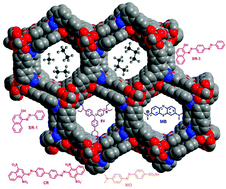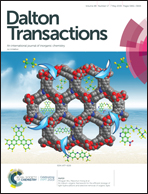An indium–organic framework for the efficient storage of light hydrocarbons and selective removal of organic dyes†
Abstract
Herein, an anionic indium–organic framework, FJI-H21, was successfully prepared using an azobenzene-derivated tetra-carboxylate ligand, which had well-shaped honeycomb-like hexagonal channels along the crystallographic b-axis and trapezoidal window-like one-dimensional channels along the crystallographic c-axis. Due to its intrinsic microporosity, FJI-H21 demonstrated highly selective storage of C2–C3 hydrocarbons over CH4 under ambient conditions; furthermore, the selectivities for equimolar light hydrocarbons/CH4, estimated by the ideal adsorbed solution theory (IAST), indicated that FJI-H21 could efficiently separate C2–C3 hydrocarbons from CH4. However, FJI-H21 could also selectively adsorb cationic dyes, such as methylene blue (MB), ethyl violet (EV) and cation red (GTL) from anionic or neutral dyes with high uptake, rapid adsorption rate, and good recyclability; especially, using microcrystalline materials developed by fast synthesis, the adsorption rate for cationic dyes was significantly improved by 100-fold as compared to that of block crystals. The abovementioned results indicate that the sizes of the samples have an important influence on their adsorption performance.



 Please wait while we load your content...
Please wait while we load your content...